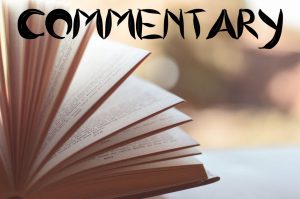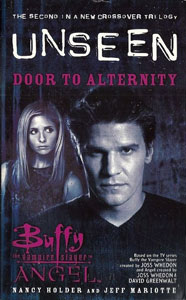Nancy Holder and Jeff Mariotte expand on their portrayal of gang warfare in Los Angeles and Sunnydale by digging into the Russian side of the Mexican-Russian conflict in “Unseen II: Door to Alternity” (July 2001), the second of a trilogy. In a backstory, the authors do some impressive writing from the point of view of scientist Alexis Vishnikoff, who believes in everything the Soviet Union stands for, and hates everything the USA stands for.
Vishnikoff’s particular passion project – not that he has much choice in what job he’s assigned to, but he is passionate about it – is the People’s Project. That’s the code name for a device that can open doors to alternate dimensions, called “alternities” in this book. In flashbacks to the 1980s, the Soviet scientists’ idea is that alternate dimensions can be a source of resources, labor and ultimately wealth to make the USSR invincible.
In the story’s present day, Vishnikoff continues working on the device, now with the goal of rebuilding the Soviet Union, and with the help of his daughter Alina, whose psychic abilities are the key to getting the device to work. This plotline is a nice commentary on how socialism ultimately runs a well dry and would then require another well.
The idea of the portals calls to mind the November 2002 “Angel” episode “Supersymmetry” (4.5), which answers the question of how Fred ended up in Pylea (as seen in Season 2) in the first place. Her professor had been dumping particularly bright students into other dimensions in order to eliminate the competition, using calculations Fred herself had discovered. “Supersymmetry” is notable for being a rare melding of science fiction and fantasy within the Buffyverse, but “Door to Alternity” used the idea more than a year earlier.
The book’s title makes me think of our heroes traveling the Ghost Roads in “The Gatekeeper Trilogy” or going into alternate realities in several other books (“Crossings” and “Chaos Bleeds”) and comics (the “Buffy” Season 8-12 Dark Horse comics). But, aside from a small subplot following Salma (Willow’s friend from UC-Sunnydale) trekking through a medieval-type dimension with extraterrestrial flora and fauna, most of “Door to Alternity” is set in the reality we’re familiar with. It seems like Book 3 will change that, though, and be one of the earliest all-out extra-dimensional romps in the book line.
I’ve spent a lot of time describing this novel without mentioning the main “Buffy” and “Angel” characters; that’s because they play less of a role here than in any other Buffyverse story where they are ostensibly the main characters. And when they do appear, it’s in incongruous situations. For example, Buffy, Riley and Willow travel through L.A. in Riley’s SUV when a muscular car-chase-and-bullets sequence like something out of “John Wick” breaks out. This is in the brutal gang warfare genre, not in the supernatural-stories-as-metaphors genre.
But even as Holder and Mariotte focus on the least “Buffy”-esque aspects of the story, a significant supernatural element is driving the overarching plot. Namely, the Vishnikoffs’ portals are snatching teenagers out of L.A. The authors pen gripping scenes where people disappear out of thin air – including one where fast-food workers vanish, leaving behind a hungry, angry mob — that call to mind the final act of “Avengers: Infinity War.” As a side effect, portals open in Sunnydale and spill out monsters, something that allows us to have standard Buffyverse fight scenes.

Although it’s not the focus, “Door to Alternity” features the best Buffy-Riley relationship writing we’ve gotten in the novels, as we see how they trust each other in the summer after “Buffy” Season 4 (although Riley is wary when Angel’s around).
Another interesting character continuity point is that certain people meet each other in this book. Continuing from “Unseen I: The Burning,” Gunn never quite crosses paths with Cordy and Wes, in order to preserve their first meeting in “Angel” Season 2. But Gunn does meet the Scooby Gang (minus Willow) in a brief jaunt to Sunnydale, and Willow – who is in L.A. helping Angel’s team — meets Kate Lockley. We’ll have to see if these meetings are remembered by writers of later crossover stories.
“Door to Alternity” will disappoint fans who want the Scooby Gang and Angel Investigations to be the center of the story. But I have to admit that when the authors dive into the supporting characters and divert to one-off passages about disappearing teens, the writing is still compelling. Even if only from an experimental standpoint, it’s interesting to read this alternate approach to Buffyverse storytelling.
Click here for an index of all of John’s “Buffy” and “Angel” reviews.

